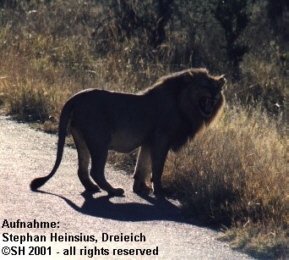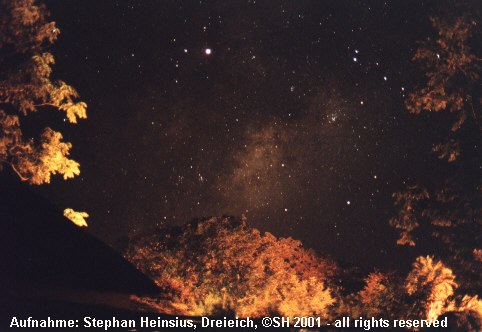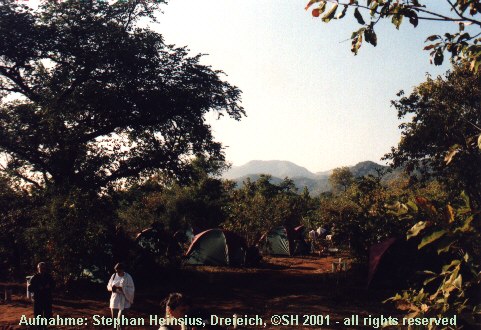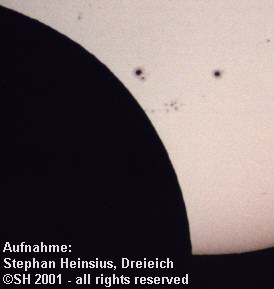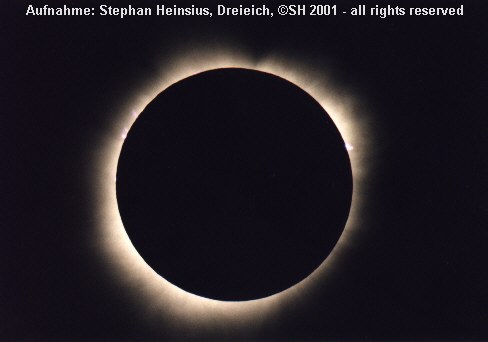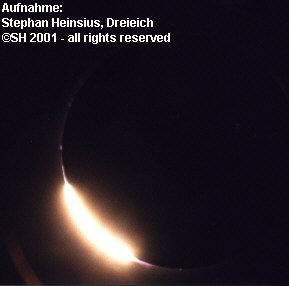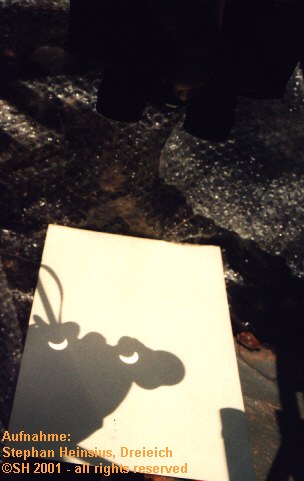Zambesi Corona
Total solar eclipse at Mavuradonha Eclipse Camp (near Muzarabani), Zimbabwe, 21. June 2001
Experience Report
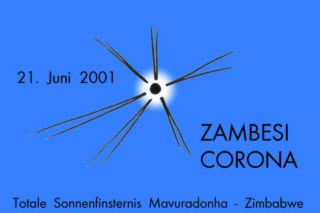
After the rainy eclipse on August 11, 1999, in Weil der Stadt near Stuttgart in Germany, I'd decided to visit the next total solar eclipse on June 21, 2001. After having checked the internet during the year 2000, I chose a journey to Zimbabwe, which had been offered by the Website "astronomie.de" and a travel agent from Zweibrücken, Germany.
One week before eclipse the group first met at Johannesburg airport, about hundred people from Germany, Austria and Switzerland. The first impression from Zimbabwe we got at the new international terminal at Harare airport. A deep blue sky, beautified with some tiny white clouds over the modern tower building, which already reflected the friendly, sunny and sophisticated flair of this African country.
The remaining six days before the eclipse offered us a wonderful, highly interesting and impressing travel through the country. Apart the ancient sacral ruins of Great Zimbabwe we visited the cities of Harare and Bulawayo, and finally the rain bursting Victoria falls in the outer northwestern part of the country. Two Safari tours in Jeeps showed us the animals of the country in Hwange national park. Their occurrence rose our whole attention and tension, like an astronomical event on nature's stage. But in difference to the forthcoming eclipse the occurrence of the animals is unpredictable, and so richer in tension, like the four Ostriches, with their heads ready for a little eclipse with the deep shining sun, or the big elephant, who trotted wheezing some meters away the cars, due to they obviously standing him in his way, and finally the lion, who turned around to show us his angry teeth, on his morning hour search for a female lionish partner.
|
Elephants at a water location |
||
|
Elephant |
Ostrich |
Lion |
Animals at Hwange National Park (18. June 2001)
The day before eclipse we went to the totality zone in the northern parts of the country. The construction of a camp at the edge of Mavuradonha Mountains at the Zambesi valley (near the village Muzarabani) had been arranged for our group. For the following two days and nights the eclipse camp should be our little mobile town to live in. Candle light lamps marking out the main way to our tents created a romantic view under the stars of the southern skies and the tender treed Mavuradonha Mountains.
|
Mars and the center of the milky way over the bush of Great Zimbabwe (16. June 2001) |
The southern cross |
|
Mavuradonha Eclipse Camp at night (21. June 2001) |
|
African nights (all pictures taken without tracking)
Thursday, June 21, 2001: now the day of eclipse had come. Viewing locations had been examined just before sunrise. I was one of the first of our group to find out the right place for eclipse observation, some fifty meters above the camp.
Smoothly the sun rose upon Zambesi valley haze, evolving just half a degree over the horizon. The red fireball went up quickly, turning into orange and then yellow glittering making the first shadows of the day at our site.
Tender blue skies over the valley beautified the edge to the valley's planes. I posted my observation equipment and myself about twenty meters east of the some meters higher position of most of the others of the group. So I would integrate them with the surrounding trees at the mountain's edge into my wide angle picture.
My observation instruments, consisting of a Revue refractor (D=60mm, f=910mm) mounted on an wooden tripod in front of a 2x teleconvertered Canon EOS500N camera on a separate tripod, loose connected by a hard stable millboard tube, so that possible vibrations by the clapping mirror of the camera would not reach the front lens. My Sony video camera DCR-VX700E (Mini-DV), also provided with a 2x teleconverter, had been mounted on a separate tripod. In addition I used 8x30 binoculars for watching and an Olympus OM1 camera with Olympus 35mm wide angle lens for some other photos.
After building up my observation instruments in the morning, I joined the camp for lunch about 1 p.m.
And then there were only another twenty minutes to go, before first contact would take place. 13:48 and the moon began shifting in front of the sun, and me not having the connection part accessible, for mounting the video camera to its tripod. I videoed freehand with 860mm equivalent focal length, before finding the missing part at about 2 p.m.. Eclipse in on, and almost 2 years late, eclipse viewers from 1999 are going to fulfill their final purpose!
|
Mavuradonha Eclipse Camp |
|
Viewing location above the camp |
Mavuradonha, Zimbabwe
|
14:09 - spot covering taken with a Canon EOS500N and 2xTele-Converter behind a Revue refractor (D=60mm, f=910mm) 1/500s exposed on Fuji200 negative film with German Baader foil (D=3.5) |
14:11 - spot covering (partial enlargement) taken with a Canon EOS500N and 2xTele-Converter behind a Revue refractor (D=60mm, f=910mm) 1/500s exposed on Fuji200 negative film with German Baader foil (D=3.5) |
"SoFi 2001" |
First partial phase - It's eclipse time again!
Now it went noticeably darker, not one cloud in the skies. Sun's crescent beamed a sharp yellow-brown light at the mountains behind us. The views through binoculars, protected by D=5.0 German Baader visual foil, showed the clearly shaped sun crescent. A group of sun spots had just been covered. The last big dot seemed to look like a little blurred heap on the moon's surface.
But this one disappeared as quickly as the ones before, and the smaller becoming crescent led us to some light and shadow games using a white blanket on the ground to project the 2001 eclipse writing „SoFi 2001“ with an adequate holed piece of paper. Our hands became tools to create sun crescents in all possible variations and to let them disappear again.
The sun crescents went smaller and smaller. I changed between joining the group, taking videos and photos of the people and playing with the sun, and going back to my site and taking other photos (with 1820mm, protected by D=3.5 German Baader photographic foil) or video sequences of the changing sun.
Now time went on to totality. Shortly after 3 p.m., another ten to fifteen minutes to go. Beginning of the “hot phase” of my recording and observation procedures: adjusting the video camera for the sun to stand at the upper right corner of the screen, to avoid walking out of sight during totality. Focus: Okay!
Now for the telescope: Where is the sun? Moved outside the view! During the partial phase I decided to change my original plans and go into totality with the whole of 1820mm, going on so well and easily adjustable to follow the sun during the partial phase. But now, a few minutes away from totality, the sun was not to be seen through that instrument. Which is the direction, where the crescent has hidden?
15:13: time has come! The view up still showed the bright glittering glint. Filters down from telescope and video camera, and the ring of corona was already visible at the video screen!
Second contact. The view through the telescope showed the whole truth. The sun's crescent must have hidden quite outside the picture's border. The corona was in view through the telescope, half of the covering moon to be seen on the left hand side.
But I didn't take a photograph. The tripod did not move quickly enough into the right direction to get the desired object fully into sight. (supplement, dated July 14, 2001: after having checked my photos I realized, that I must have taken one at second contact, badly focussed but with the complete inner corona)
Not to loose too much time, I began with the 35mm wide angle photos with the Olympus camera. It's so yellowish and not so bright as it is to see with the naked eye. Is it worth to take that picture? The next planned picture, the view into the plains, was not too convincing. But I put the trigger and took these photos, the next one: the mountains behind me, covered by the moon's shadow. It was all not so bright as in Guadeloupe on February 26, 1998, quite more hazy.
|
Corona and Jupiter |
Moon shadow over the Zambesi Valley |
Mavuradonha mountains in the moon shadow |
15:14 - Total solar eclipse in Mavuradohna, Zimbabwe
taken with a Olympus OM1 and Olympus 35mm-lens, 1/8s exposed at f2.8 on Fuji 400 negative film
One glimpse of a sight up to the covered sun: like a giant mighty beaming power beside the mountains’ edge, moon's shadow cone appearing out of the light bands of the corona laid down over us fully covering the valley's plains. The deepness of the shadow seemed to have erased the sun's disk, leaving only the long arms of its beams aside.
Like a giant sky blossom this corona broke out with second contact. Accompanied at the lower left side by planet Jupiter, which sparkled at the tender blue sky, from the far away other side of the sun back to us.
Now there was time.
What next? Really not make the 1820mm photos of the corona, having carried all the weight for the partial phase only? No, try again to adjust that now.
Some way I managed to get the covering moon into the right view, but the focus: Is it really sharp? Moving left, right, up, down the camera by adjusting the tripod's position and height, going back to the middle of sharpness, finally being satisfied. Go! Along with that exposures, bringing one time after another through. Taking so long, only one exposure at a time, having forgotten to initialize three shot exposure (plus minus one aperture). Go, go, go, getting more and more exposure times through.
The sun didn't loose its light. It was bright enough to read exposure values on the camera's display.
|
Corona 15:15:26 |
Great prominence at the eastern solar limb (partial enlargement) |
|
Inner corona and prominences 15:15:47 |
Prominences at the western solar limb (partial enlargement) |
Total solar eclipse through the telescope at 1820mm focal length
taken with a Canon EOS500N and 2xTele-Converter behind a Revue refractor (D=60mm, f=910mm) on Fuji200 negative film
|
The pictures through the Revue refractor were taken focally, without a fixed connection between camera and telescope. Only a loose adjusted hard stable millboard tube protected the pictures against sidely light fall. The camera was mounted on a separate tripod. Tracking of the picture's view and focussing had to be done permanently. Because of being near the equator (16° south) most part of the seemingly sun movement could have been compensated by height adjustment at the tripod conveniently using a tripod's crank. Applying this technique the risk of disfocussiation is quite high, but the separation of camera and telescope has the great advantage, that vibrations of the clapping mirror of the camera can not lead to a blurring of the picture. |
During the telescope's adjustment and photo shooting I could see a triangle shaped prominence at the right side of the sun: fully in pink, not that purple, I thought before, but concentrated, to get the picture sharp, and not to freeze in admiration.
And the corona is so giant here, not that small tender garland, I had seen in Guadeloupe! In countless channels it beamed out behind the moon, making the prominence quite inconspicuous, even at 1820mm focal length. The whole picture was covered with white yellowish beams. It was a completely different view, as I had thought, such a bright one, mainly consisting of these channels.
What? Going to be over now? Down at the right side, the coronal background became brighter, more and more brighter, and look: there are prominences, so many prominences! Many little prominences coming out aside the unstoppable fast running moon.
|
15:16:40 - First light at 15:16:40 - First light at third contact taken with a Canon EOS500N and 2xTele-Converter behind a Revue refractor (D=60mm, f=910mm) 1/125s exposed on Fuji200 negative film |
|
15:16:43 - Bailey's beads with interferences taken with a Canon EOS500N and 2xTele-Converter behind a Revue refractor (D=60mm, f=910mm) 1/250s exposed on Fuji200 negative film |
The new light - prominences, chromosphere and Bailey's beads
And behind them the chromosphere! And there are the sun beams again! Several light dots growing over the lunar limb, and the direct view with the naked eye is confirming: That was third contact. The corona is being beamed away, getting the last glance through the video screen, increasing aperture value, to get a last view before putting on filters again, to protect the camera against the mighty glitter of the new sun crescent.
Is it already over? A direct view into the sunbeams with the naked eye lets you divine the past view, but it is so glittering bright. I am accepting: it is over!
There remains a mouldy feeling of discontent. I needed so long for focussing, and the video pictures are over exposed. Having seen that fantastic picture (with the naked eye) only two or three seconds, that was much too short. And I took no photo at 910mm.
Okay, that corona was too big for 910mm, wouldn't have fitted into the picture. That faint feeling in the stomach still took effect for a while. Let's hear what the others have got. Several people had similar problems with instruments and recording procedures. It is just too overwhelming, so that it's hard to only proceed the way you have planned before.
Now there were the sun crescents again and time to take other photos or video sequences.
|
15:16:52 Sun crescent and prominences taken with a Canon EOS500N and 2xTele-Converter behind a Revue refractor (D=60mm, f=910mm) 1/250s exposed on Fuji200 negative film |
Projecting sun crescents using 8x30 binoculars |
|
16:28 Several seconds before fourth contact taken with a Canon EOS500N and 2xTele-Converter behind a Revue refractor (D=60mm, f=910mm) 1/250s exposed on Fuji200 negative film with German Baader foil (D=3.5) |
Second partial phase
With inconspicuous fourth contact, the moon left the sun's disk again. The full sun was preparing for sunset now, in about the next hour or so.
Due to expected incoming darkness, the others decided not to stay for sunset. I joined them and packed my things together. One of the security men, whom I gave two eclipse viewers at noon, now helped me carrying my luggage back to the camp.
At the evening we began to exchange our videos by making copies of each other's tapes. My video was quite well, better than I've thought. The pictures were overexposed only after third contact, because I switched off automatic aperture adjustment during totality. But the real impression of the beaming deepness and dynamics and brightness of the eclipsed sun, couldn't be fixed by that video, even not by any other I have ever seen.
We left the camp the day after the eclipse, and so the Zambesi valley and Mavuradonha Mountains. The flight back home was again via Johannesburg, where our group dispersed, having last good byes at Frankfurt airport, from where a taxi brought me home.
Now at home again, there is the same nice weather like in Zimbabwe, and sunsets led me to take some other pictures with the same optics at 1820mm, so to say as a training for the next sun eclipse, because I now just can not imagine, that there is any more beautiful thing to experience.
Stephan Heinsius, written down in German on 23.06.2001 to 29.06.2001, translated into English at 29.06.2001.
Pictures inserted on 13.07.2001.
|
Beobachtungsinstrumente Revue refractor mounted on a wooden tripod on the left, Canon EOS500N behind it on a separate tripod, on the right the video camera Sony DCR-VX700E |
Moon in Harare on 22. June 2001, 27 hours after the sun eclipse taken with a Canon EOS500N and Canon tele zoom 75-300mm at 200mm and f4.5, 2 seconds exposed on Fuji200 negative film |
Design and contents: Stephan Heinsius, D-63303 Dreieich, ©SH 2001 - all rights reserved






